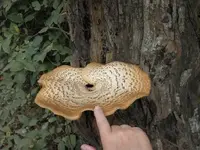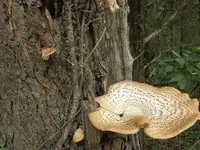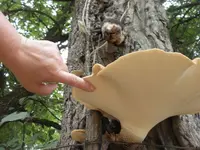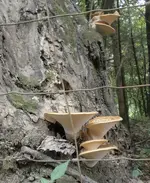Revisited, and saw your finger in 2 of the photos. If you are female (mamabear), I'd guess the larger fungus is 15 inches or more across? The underside is comprised of tiny tubes tightly packed together, making this for certain a member of the Polyporaceae (many pores family), a huge fungal group including Polyporus, Ganoderma, Trametes, Stereum, Laetiporus and a host of others that grow on dead or dying trees or straw. Provided it is 15 inches wide or wider, it is probably Polyporus squamosus and known to be edible. (Most fungi are. Even deadly fungi can be eaten ... once.) It may have medicinal value. Similar Ganoderma lucidum (Reishi) known to stimulate the immune system, and stimulates production of both alpha- and beta-interferon, beneficial in some cancer treatments as well as the common cold. In China, Reishi was reserved for royalty only, and was sometimes called "Herb of 10,000 Days". The tiny related Trametes versicolor or Turkey Tail, is also among the most sought-out traditional herbs in the Chinese pharmacopaea, and is used for both cancer treatment as a pain killer, like aspirin. T. versicolor sells out quickly in Chinese markets for that reason. (See Mushrooms: Poisons and Panaceas for more information.)
While fungi may look more like plants (herbs) than animals, they are more closely related to animals than plants, and have their own Kingdom in today's scientific organization of life. Fungal spores (seeds) can survive extreme heat, cold, and dehydration, yet still germinate (sprout). Fungi found in Egyptian tombs for thousands of years have been grown. It has been theorized life might have been introduced on Earth by way of embedded fungal spores in meteorites or comets.










